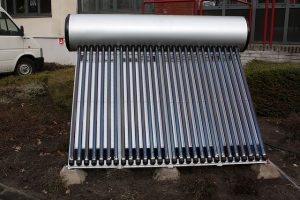 Most homes use either electricity or natural gas to power their water heaters, and while these work fine, they can add up in additional energy expenses over the month. Depending on the size of your home and how much water your family uses, you can expect to spend around $600-$800 a year just to power your water heater. An alternative, more cost-effective method, however, is to use a solar water heater. Contrary to popular belief, they’re actually fairly easy to set up and work extremely well in providing your home with all the hot water it needs. If you’re interested in learning more about them, keep reading and we’ll explain how solar water heaters work and why you should consider installing one in your home.
Most homes use either electricity or natural gas to power their water heaters, and while these work fine, they can add up in additional energy expenses over the month. Depending on the size of your home and how much water your family uses, you can expect to spend around $600-$800 a year just to power your water heater. An alternative, more cost-effective method, however, is to use a solar water heater. Contrary to popular belief, they’re actually fairly easy to set up and work extremely well in providing your home with all the hot water it needs. If you’re interested in learning more about them, keep reading and we’ll explain how solar water heaters work and why you should consider installing one in your home.
Basics of Solar Water Heaters
Although there are a few different types available, most solar water heaters feature the use of a solar collector and tank. These two primary components are usually mounted on the home’s roof where it will receive the greatest amount of sun exposure. Contrary to popular belief, the solar collector doesn’t actually consist of photovoltaic cells such as those found in solar panels, but instead it’s made of a dark insulated, waterproof material that absorbs the sunlight. Beneath the surface of the solar collector are tubes where the passing water is warmed by the thermal heat generated from the sun.
It’s important to note that most solar water heaters still require the use of some alternate means of energy to heat the water. When it’s sunny and the sky is cloud-free, you system shouldn’t have a problem generating the necessary energy to heat enough water for your home, but this isn’t always the case. When it’s raining, snowing or just an overcast, your system won’t generate as much energy; therefore, your water won’t heat as
Active Solar Water Heaters
Solar water heaters usually fall into one of two primary categories – active or passive. While both of these types can effectively produce hot water for you and your family, there are a couple of noticeable differences between the two.
There are two main types of active solar water heaters – direct and indirect circulation. In direct circulation systems, the water traveling through the collectors goes directly into the home. These are the most basic type of solar water heater available, but they typically only work well in warm climates where the temperature doesn’t frequently drop below freezing.
Indirect circulation solar water heater uses a pump combined with anti-freeze to help push the water through the system and into the home. Because it uses anti-freeze, indirect circulation is a popular method for homes in colder climates where there’s a constant threat of water freezing in the pipes.
Passive Solar Water Heater
Now that you know a little bit about active solar water heaters, lets take a look at passive. Integral collector-storage is a common type of passive solar water heater that’s designed for homes in warm climates. This method doesn’t use a pump, but rather the warm water automatically travels down into the normal water heater, which means you’ll still be required to use either gas or electricity to supplement the heating of your home’s water.
Lastly, Thermosyphon systems is a type of passive solar water that’s more suitable for colder climates and environments. In these systems, the tank must be installed above the solar collector so the warm water will rise as the cool water drops. As a result, there’s no need for a pump to be installed or used in a Thermosyphon system.
